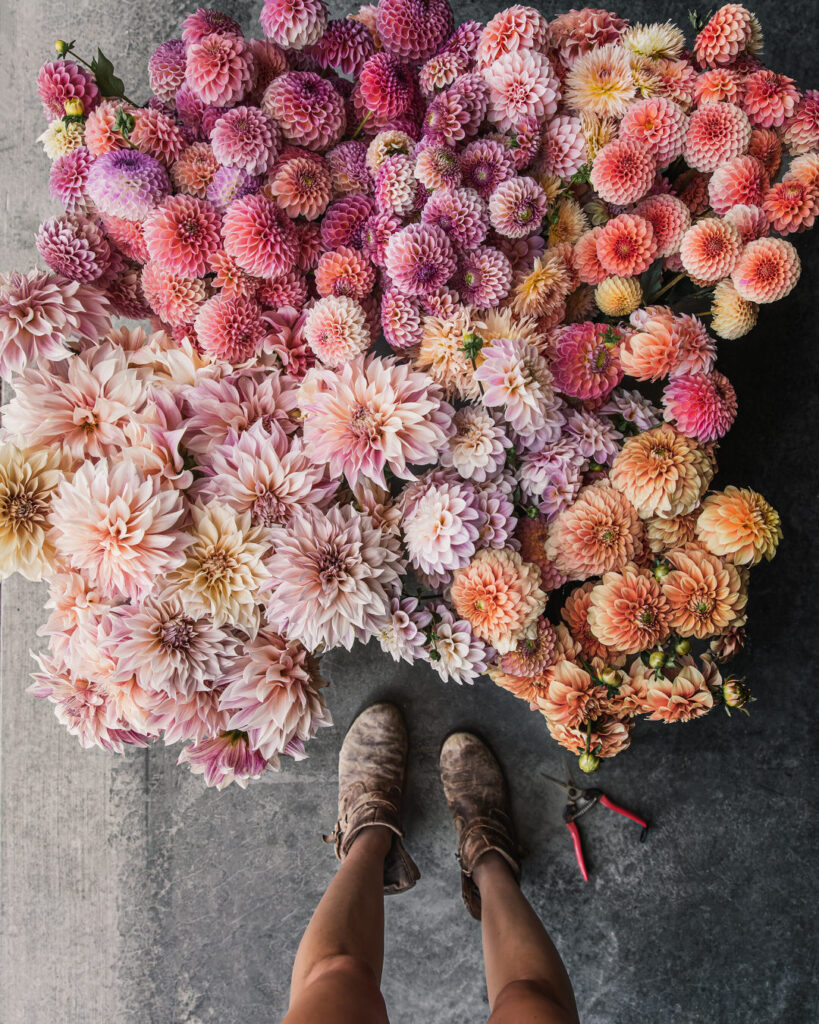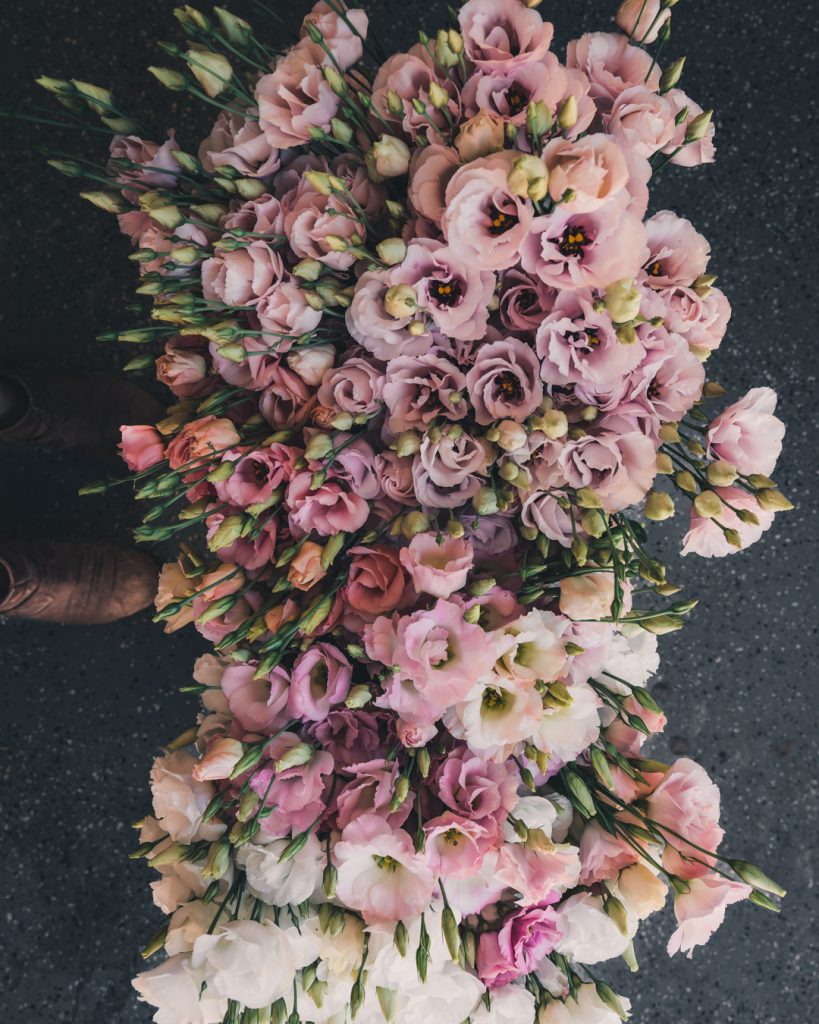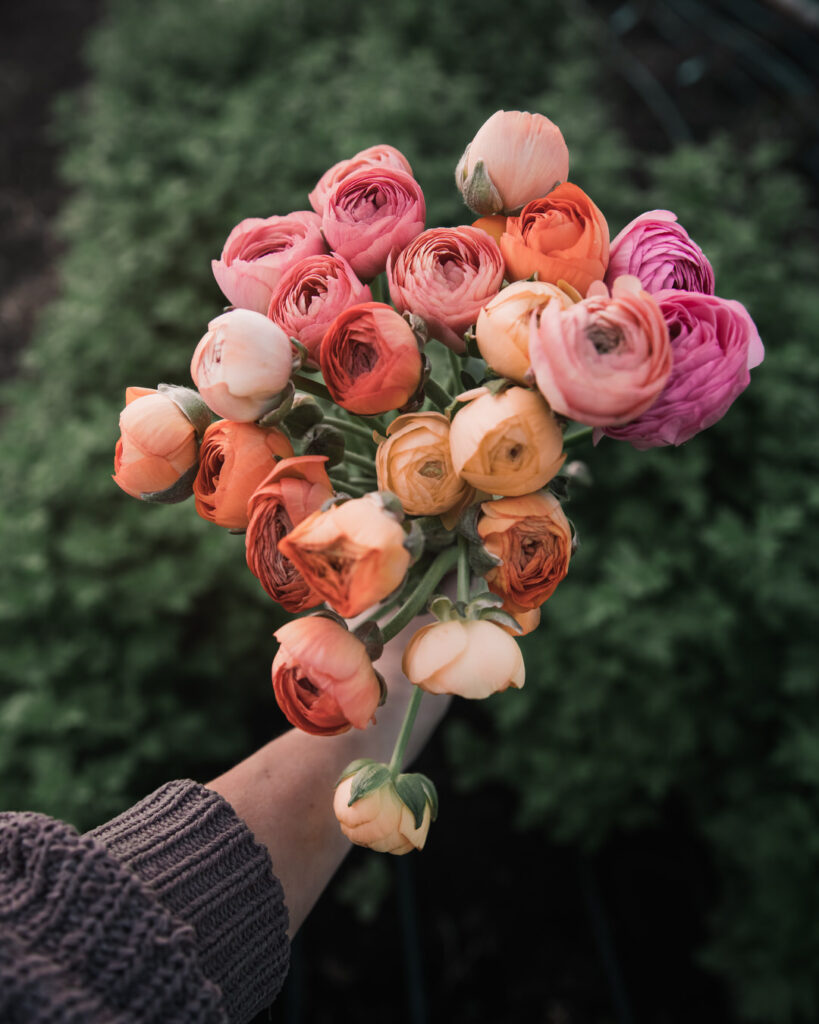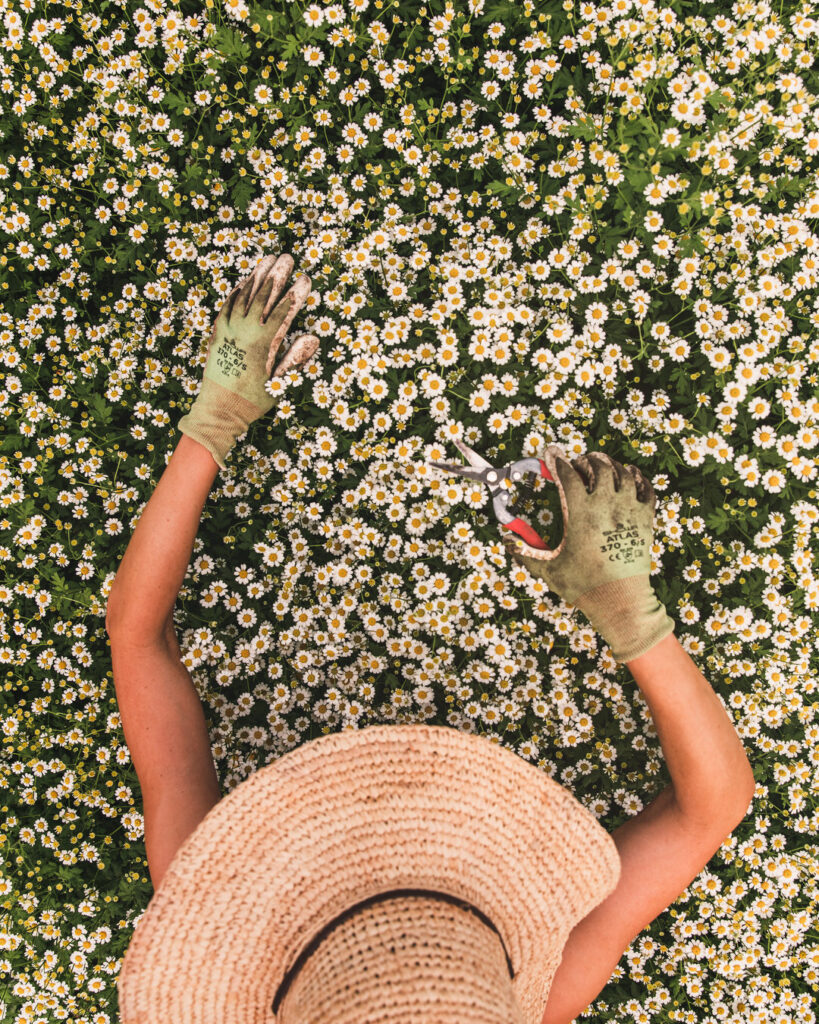Did you know that postharvest solutions have been shown to extend the vase life of cut flowers by more than 60% (Benzakein)? While decades of research have confirmed that they are extremely effective in extending longevity and maintaining quality, it’s important to understand the implications of the various postharvest solutions. There are different solutions for different situations, and not all cut flowers respond positively to all solutions.

Postharvest Solutions Introduction
When we started our farm, customer satisfaction was (and still is) a major goal. Based on all of the data on the efficacy of postharvest solutions, as well as recommendations from leaders in the flower farming industry, I wanted to explore using them to ensure a high-quality product.
While the concept of postharvest solutions made sense, I was totally confused by all of the options at first! After years of research and personal experience, I’ve simplified the process for our farm. And if you’re feeling like I was, I hope I can simplify it for you too.
In this article, I’ll outline the four main functions of postharvest solutions, the four main groups by intended use, provide product recommendations, and share exactly what we do here on our farm. Finally, I’ll share my personal thoughts on the use of postharvest solutions, as well as alternatives for the future.


Postharvest Solutions: Four Main Functions
To better understand postharvest solutions, let’s dive into their key ingredients which help perform four main functions.
Sugars/Carbohydrates
Cut flowers require adequate carbohydrate reserves for metabolic activities. Because many flowers are harvested before they are fully developed for cut flower production, the development of the flower buds requires food (i.e., carbohydrates). When stored carbohydrates are low, leaves and flowers senesce rapidly and petals that develop at low sugar levels have paler colors (Postharvest Handling).
Even cultivars that are harvested more mature likely will not have adequate carbohydrate stores for maximum life. Also, harvest time can greatly impact carbohydrate stores (see Harvest Time in this article).
For this reason, introducing a carbohydrate such as sugar can supplement reserves for metabolic activities, delaying senescence and improving overall quality. However, it’s important to note that a sugar solution is also perfect for the growth of microorganisms!
Germicide/Biocide
The problem with microorganisms is that the microbial growth causes blockage of the water-conductive cells in plant stems. Biocides help prevent bacteria in stems and water, thereby promoting water uptake.
Acidifier
Similarly, acidifiers suppress microbial development (which promotes water uptake), but they also promote water uptake through a different mechanism which also is thought to help prevent wilting. Acidifiers lower the pH of water. It has been shown that low pH water (pH=3.5) travels faster in the water-conducting system (xylem), thereby preventing or reducing wilting that frequently occurs in field-grown flowers (UMASS).
Plant Growth Regulators (PGRs)
There are preservatives that either mimic or modify the actions of endogenous PGRs. Some preservatives may contain PGRs or plant growth inhibitors to prevent stem bending, stem elongation and prevent leaf yellowing, while others may limit the action of other PGRs such as ethylene (Postharvest Handling).

Postharvest Solutions: Four Main Groups
Commercial postharvest solutions will have one or a combination of the above ingredients and can be categorized into four main groups depending on their intended use:
Hydrators
Hydrators are designed to accelerate water uptake and restore water balance. Many flowers benefit from being cut into a hydrating solution, especially during warm weather. Commercial hydrating solutions typically don’t contain sugar, so they’re not appropriate for long-term storage. In fact, some cuts may be damaged if kept in hydrating solution too long.
Think of hydrating solution as the go-to product for right after harvest to help keep stems hydrated and prevent wilting. Two examples of commercial hydrating solutions are Chrysal Professional 1 and FloraLife HydraFlor. To use a hydrator solution, pump the solution into harvest buckets prior to harvesting, following label dosage instructions.
“Quick-dip” solutions are the industry standard for excellerating the hydration process for wilt-prone stems like geranium or red-leaf hibiscus. They reduce bent necks and wilty stems. As the name implies, stems are dipped quickly into the solution (just a few seconds). FloraLife Quick Dip is actually listed as a hydrator, while Chrysal Easy Dip is listed as a preconditioner for enhanced hydration. See Harvest & Postharvest Cheat Sheet for a list of wilt-prone varieties.
Slow-release chlorine tablets are hydrators in pill form that are particularly effective for “dirty flowers.” Flower farmers refer to a certain group of flowers as “dirty” flowers because they pollute the water faster than others and are also more sensitive to pollution. Slow-release chlorine tablets, such as Chrysal CVBN Gerb Pill, are particularly effective at combatting premature water pollution with these flowers. They are effective for 2–3 days. See Harvest & Postharvest Cheat Sheet for a list of “dirty” varieties.
Holding Solutions
Holding solutions are suited for longer-term storage (2 days or more) or transport. Holding solutions typically contain a small amount of sugar, an acidifying agent, and a biocide to keep water optimum for up to 5 days (Postharvest Handling; Benzakein).
Think of holding solutions as the go-to product for longer-term storage or transport/delivery. Holding solutions are appropriate for anyone who holds flowers for more than a couple of days, delivers mixed bouquets, provides grocery store flowers, and/or supplies florists. Two examples of commercial holding solutions are Chrysal Professional 2 and FloraLife Storage 200.
Consumer Flower Foods/Vase Solutions
Consumer flower foods and professional vase solutions are intended for arrangements and bouquets for the final end user. They keep flowers vibrant, help with water uptake, and extend vase life. They generally contain higher sugar levels, an acidifier, and a biocide. They can also be used with warm water to open up flowers quickly for an event. Two examples of commercial vase solutions are Chrysal Professional 3 and FloraLife Flower Food 300. Flower food packets can also be purchased in bulk for the end consumer.
Anti-Ethylene Agents
Anti-ethyene agents, as their name suggets, are used to reduce or prevent damage from ethylene. I discuss ethylene more in-depth here. Two examples of anti-ethylene agents are Silver Thiosulfate (STS) and 1-Methylcyclopropene (1-MCP). While all commercial solutions have specific application rates, these must be applied extremely precisely and also have strict disposal requirements.
Important Note
As I’m sure is evident by now, there is not a one-stop solution when it comes to commercial flower solutions. Their use is not only dependent on intention and storage, but also on unique cultivars. Although I listed a few examples above, there are many solutions that fall into these categories, some specific to particular varieties (like rose or hydrangea solutions). Regardless of solution used, it’s important to follow label instructions.
While research has shown that most flowers benefit from commercial postharvest solutions, some cultivars show no effect at all (or on some occasions, a reduction in vase life). See Harvest & Postharvest Cheat Sheet for more specific research on particular cultivars. At remember to experiment!

Postharvest Solutions at Petal Back Farm
On our farm, we use hydrators, holding solutions, and flower food but do not use anti-ethylene agents. I’ll outline what we typically do on our farm, but this does not apply to all flowers (see Cheat Sheet or Plant Profiles for specific recommendations by variety). If nothing specific is listed, this is typically what I do:
General Process
In general, I’ll use a hydrator (Chrysal Professional 1) in harvest buckets when the weather is particularly warm or I’m harvesting more wilt-prone flowers. Flowers rest in this solution anywhere from 4 hours to overnight.
Flowers that will be stored for longer than a few days are moved to buckets with holding solution (Chrysal Professional 2). Some flowers, like lisianthus and sunflowers, I’ll harvest directly into holding solution. Florist orders and bouquets for delivery are transported in holding solution. Arrangements get flower food and I include packets of flower food for retail customers.
Special Cases: “Dirty Flowers” and Especially Wilt-Prone Flowers
I dip especially wilt-prone flowers (listed in Cheat Sheet) in Chrysal Easy Dip once back in the shop. I use Chrysal CVBN tablets for “dirty flowers.”
Chrysal is simply the first product I used and it worked well. I typically purchase during Black Friday sales.

Important Note & Alternative Solutions
While postharvest products are industry standard, it’s important to note that they are not approved for organic production. Using these products is a personal choice that each farm/florist has to make. While we grow everything organically, we are not certified organic on our farm.
I first learned about postharvest products through Floret/Erin Benzakein, and I do find they make a difference. Our customers have communicated that they prefer this balanced approach of gentle growing practices combined with a better-quality and longer-lasting product.
That said, I think the industry has a lot of opportunity for improvement here. So, I’ve also dedicated a considerable amount of research into this area and shared an article earlier this month on some of the most-recent data on the use of essential oils for cut flower preservation.
While postharvest solutions have been shown to increase vase life and quality, you can absolutely have gorgeous flowers without them! Truly, the number one thing you can do for your flowers is cleanliness. Even the best postharvest solution cannot overcome poor sanitation. Clean buckets and tools are absolutely key! Similarly, employing proper harvesting techniques can drastically improve vase life (read a breakdown of these here). And remember: the ephemeral quality of flowers is what makes them so special afterall.

Sources
- CVBN Pre-Treatment. The Gardner’s Workshop.
- Floret Farm’s Cut Flower Garden: Grow, Harvest, and Arrange Stunning Seasonal Blooms (Benzakein, Chai, et al). Floret Farms x Chronicle Books.
- Harvesting and Handling Cut Flowers. Center for Agriculture, Food, and the Environment
- UMass Extension Greenhouse Crops and Floriculture Program. Last update August 2016.
- Invest in the Right Solutions (Nell). The magazine of the Society of American Florists (SAF) (PDF).
- Postharvest Handling of Cut Flowers and Greens: A Practical Guide for Commercial Growers, Wholesalers & Retailers (Dole, Stamps, Carlson, et al).
- Sugar and Acidity in Preservative Solutions for Field-Grown Cut Flowers (Han). Stockbridge School of Agriculture, University of Massachusetts, Amherst.
cLICK FOR Comments +